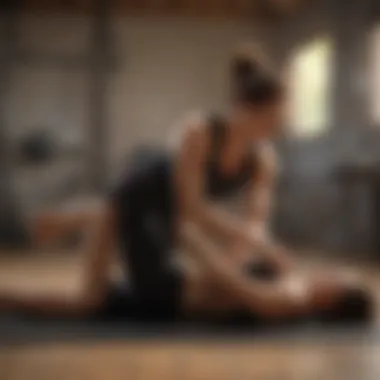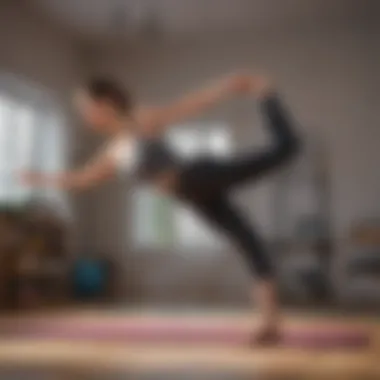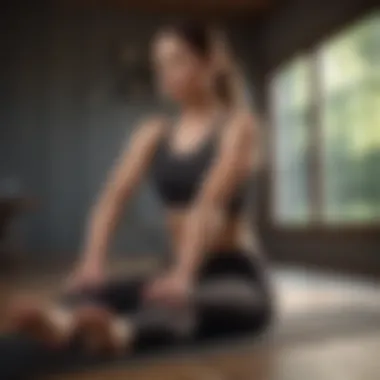In-Depth Guide to Understanding Pilates Exercises


Intro
Pilates, a method developed by Joseph Pilates in the early 20th century, is not merely a form of exercise; it represents a holistic approach to physical and mental well-being. This regimen focuses on core strength, flexibility, and efficient alignment of the body. As more individuals seek sustainable health practices, understanding Pilates can offer valuable insights.
The origins of Pilates trace back to rehabilitation for soldiers and dancers, which gives it a unique perspective in fitness. The principles underpinning Pilates emphasize control, precision, and breath, allowing practitioners to connect mind and body. Through detailed exploration of various techniques, this article will highlight how Pilates can effectively enhance physical health, contribute to mental clarity, and offer practical applications in everyday life.
Whether you are new to fitness or looking to deepen your practice, recognizing the full spectrum of benefits that Pilates provides is essential. This understanding not only enriches personal fitness journeys but also fosters awareness of broader collective wellness trends.
Intro to Pilates Exercises
Pilates is more than just an exercise; it is a discipline that invites thoughtful engagement with one's body. This section serves as an essential introduction to the complexities and nuances of Pilates exercises, highlighting their significance in fitness and rehabilitation. Through the careful exploration of foundational principles and techniques, readers will appreciate how Pilates can contribute to overall well-being. Importantly, understanding the varied dimensions of Pilates equips individuals to incorporate its practices effectively into their lives, whether for fitness improvement, stress relief, or recovery.
Overview of Pilates
Pilates is a mind-body exercise system, focusing on core strength, flexibility, and posture. Developed in the early 20th century, it synthesizes elements from yoga, dance, and calisthenics to create a holistic approach to physical fitness. One of the striking features of Pilates is its versatility, making it suitable for a wide demographic ranging from athletes to seniors. The exercises can be adapted to different levels of strength and flexibility, which further broadens its appeal.
In essence, Pilates emphasizes control and precision over raw strength. Practitioners engage in a series of controlled movements, which fosters awareness of body alignment and muscle engagement. This aspect of Pilates not only enhances performance in other sports and activities but also promotes better posture and alignment, which can mitigate the risk of injury. Additionally, regular practice of Pilates can facilitate improved body awareness, aiding individuals in understanding their physical capabilities and limitations.
The Founder: Joseph Pilates
Joseph Pilates, born in 1883 in Germany, was a visionary who developed this exercise system, initially called "Contrology." His approach was inspired by his own experiences with physical ailments and his early influences in gymnastics, yoga, and martial arts. During World War I, Joseph worked with injured soldiers, adapting his techniques to help them regain strength and mobility. This period was crucial in shaping his methodologies and principles.
In 1926, he emigrated to the United States, where he opened his first studio in New York City. Here, Joseph's work gained prominence, particularly among dancers and athletes who appreciated his focus on core strength and flexibility. His commitment to quality movement and a strong mind-body connection set the foundation for what would become a widespread fitness movement.
Joseph's legacy continues to influence the way Pilates is taught and practiced today. The principles he established, such as concentration, control, and breath awareness, remain integral to the discipline. By understanding Joseph Pilates’s visionary teachings, practitioners can better appreciate the philosophy behind Pilates exercises and apply this knowledge to enhance their personal fitness journeys.
Core Principles of Pilates
The core principles of Pilates form the backbone of this exercise system. They provide a foundation that supports the various techniques and routines practiced in a Pilates class. Understanding these principles is crucial for anyone looking to enhance their physical fitness and wellbeing. They highlight the importance of conscious movement and body connection.
These principles not only lead to improved physical health but also support mental clarity. Practicing Pilates allows individuals to develop awareness of their body movements, which can have a positive impact on daily activities. This focus on mindfulness contributes to better performance in both exercise and everyday tasks.
Concentration in Movement
Concentration is a fundamental aspect of Pilates. It emphasizes the need to be present and aware during each exercise. When performing Pilates movements, practitioners are encouraged to focus on their body, the rhythm of their breath, and the alignment of their posture. This heightened awareness fosters better control over movements, ultimately leading to more effective workouts.
Practicing concentration not only enhances the physical benefits of Pilates but also helps in improving mental focus. A solid focus can transform an ordinary session into a highly productive one.
Control and Precision
Control and precision are at the heart of Pilates. Each movement should be executed with careful intent. This helps to avoid injury and allows for maximum benefit from the exercises. Unlike other workout styles that may prioritize speed, Pilates champions quality over quantity.
By emphasizing control, practitioners develop a deeper connection to their muscles. Precision in movement ensures that the correct muscle groups are engaged. This focus leads to better results in strength, stability, and flexibility.
Breath Awareness
Breath awareness plays a critical role in Pilates. The practice teaches individuals to synchronize their breath with movement. This connection helps to enhance oxygen flow to muscles, improving overall performance. Proper breathing techniques are essential for relaxation and can reduce tension in the body.
Breath awareness also supports maintaining a steady rhythm during exercises. This can help manage effort levels and contribute to a more enjoyable workout experience. Developing this awareness enables practitioners to tap into their body’s natural energy flow.
Flow and Efficiency
Flow refers to the smooth transition between movements in Pilates. A strong flow creates a sense of rhythm that enhances the workout experience. This principle emphasizes that movements should connect seamlessly, promoting optimal efficiency.


Efficient movement patterns can lead to a more effective workout. By focusing on flow, practitioners avoid unnecessary strain and fatigue. Moreover, this aspect contributes to a feeling of grace and fluidity in movement, which can be rewarding on many levels.
Isolation of Muscle Groups
Isolation of muscle groups is vital in Pilates. This principle allows practitioners to engage specific muscles without involving surrounding areas. It encourages a deeper understanding of how different muscle groups work in conjunction.
Focusing on isolated movements enables targeted strengthening, which is beneficial for rehabilitation and injury prevention. It also helps enhance overall body coordination. By understanding how to engage muscles independently, individuals can improve their performance in many physical activities.
Types of Pilates Exercises
Understanding the different types of Pilates exercises is essential for anyone looking to enhance their fitness journey. Each method offers unique benefits and caters to various preferences and fitness levels. Knowing these options allows participants to make informed decisions based on their goals, physical condition, and personal preferences.
Mat-Based Pilates
Mat-based Pilates is often the entry point for many practitioners. This approach utilizes a mat and the body’s own weight for resistance. It can be done almost anywhere, which adds to its appeal. The mat technique emphasizes core strength, flexibility, and balance through exercises like the Hundreds, Roll Ups, and Leg Circles.
This form is particularly beneficial for beginners. It helps develop a strong foundation in the principles of Pilates, focusing on proper alignment and controlled movements. Furthermore, participants can perform mat-based exercises at home, making it an accessible and convenient practice. It encourages engagement with one’s body, enhancing both physical and mental connection.
Reformer Pilates
Reformer Pilates introduces a machine designed by Joseph Pilates, called the Reformer. This equipment uses springs, pulleys, and a sliding carriage to create resistance. This method allows for a greater range of motion and more varied exercises compared to mat-based Pilates.
Reformer Pilates is beneficial for those looking to deepen their practice. The machine provides support and resistance, making it easier to perform exercises correctly. Practitioners can target specific muscle groups while maintaining control throughout their movements. The versatility of the Reformer means it can challenge even advanced practitioners.
For rehabilitation, the Reformer is especially helpful. It offers adjustable resistance that can cater to individual needs. This makes it suitable for both stronger individuals and those recovering from injuries.
Pilates with Equipment
Pilates can also incorporate various specialized equipment aside from the Reformer. Tools such as the Cadillac, Pilates chair, and resistance bands expand the repertoire of exercises available. Each piece of equipment targets different areas of the body and enhances the overall Pilates experience.
Utilizing equipment can provide additional support, allowing beginners to execute moves that might be challenging on a mat. For advanced practitioners, the equipment can add complexity and variation, keeping workouts engaging and effective.
Physiological Benefits of Pilates
Pilates offers a wide range of physiological benefits that contribute to both physical and mental well-being. This section will explore how it enhances core strength, improves flexibility, ensures proper postural alignment, helps in injury prevention, and provides mental focus and stress relief. By understanding these advantages, readers can appreciate how Pilates serves not only as a workout but also as a holistic approach to overall health.
Enhancing Core Strength
The core is a vital part of the body, consisting of muscles in the abdomen, lower back, and pelvis. Pilates focuses heavily on strengthening these muscles through controlled movements. A strong core supports the spine and improves balance and stability. When practitioners engage in Pilates, they learn to activate and stabilize their core effectively. This not only aids in performing exercises but also translates to better performance in daily activities. Some key benefits include:
- Improved athletic performance
- Better posture
- Increased stability in movements
Improving Flexibility
One of the hallmark features of Pilates is its emphasis on stretching and elongating muscles. This practice helps enhance flexibility over time, which is essential for preventing injuries. As muscles become more flexible, they can perform with a larger range of motion. This adjustment can be particularly beneficial for those who lead a sedentary lifestyle or engage in repetitive activities. Key points include:
- Increased range of motion
- Reduced risk of injuries
- Enhanced performance in other sports
Postural Alignment
Proper postural alignment is critical in reducing physical strain and discomfort. Pilates explicitly addresses this through various exercises designed to align the spine and pelvic region. This practice helps individuals become more aware of their body mechanics. Maintaining good posture has numerous advantages, such as:
- Reduced back pain
- Improved breathing
- Enhanced self-confidence
Injury Prevention


Pilates' focus on core strength, flexibility, and alignment contributes substantially to injury prevention. The method teaches practitioners proper movement patterns that reduce the likelihood of developing issues related to muscle imbalances and poor posture. Furthermore, Pilates can assist in rehabilitation, allowing individuals to return to normal activities more safely. Benefits include:
- Strengthening underused muscles
- Improving coordination
- Lowering the risk of reinjury
Mental Focus and Stress Relief
Engaging in Pilates doesn't just stimulate the body; it also cultivates mental well-being. The concentration required to execute movements effectively encourages mindfulness. Breath control during exercises fosters a meditative state that can alleviate stress. Regular practice can lead to:
- Improved mental clarity
- Reduced anxiety
- Enhanced sense of relaxation
Pilates emphasizes the connection between the mind and body. This integration promotes a well-rounded approach to fitness and wellness.
In summary, the physiological benefits of Pilates extend well beyond physical fitness. They encompass a comprehensive improvement in individuals' mental and emotional states, making it a valuable practice for anyone looking to enhance their overall quality of life.
Pilates in Rehabilitation
Pilates plays a significant role in rehabilitation. It offers a tailored approach that addresses specific needs of individuals recovering from injuries or surgeries. This method is not only about physical exercise; it emphasizes a complete integration of mind and body, which is essential for effective recovery. This section will explore how Pilates supports rehabilitation in three main areas: post-surgery recovery, managing chronic pain, and enhancing overall mobility.
Post-Surgery Recovery
After surgery, the body often undergoes a long rehabilitation process. Pilates can facilitate this by strengthening muscles that may have weakened due to periods of inactivity. It is crucial to understand that these exercises must be adapted to the individual’s condition.
- Start Slow: Initially, patients should focus on gentle movements, gradually increasing intensity as strength returns.
- Core Strength: Pilates emphasizes core engagement which can help stabilize the body post-surgery.
- Alignment and Balance: Correct alignment is essential. Pilates can teach patients how to move correctly, thus minimizing the risk of further injury.
Incorporating Pilates into post-surgery rehabilitation can improve recovery time and help individuals regain confidence in their physical abilities.
Managing Chronic Pain
Chronic pain can drastically affect daily life. Pilates offers techniques that increase awareness of body mechanics, which can relieve discomfort. Practicing these exercises may provide relief through:
- Enhanced Flexibility: Stretching tight muscles reduces tension, which can be a source of pain.
- Improved Posture: Good posture can alleviate pressure on the spine and surrounding structures, helping to manage pain.
- Mind-Body Connection: By focusing on breathing and movement, participants can learn to manage pain through mental awareness.
Pilates does not replace professional medical advice but can complement traditional treatments for chronic pain, making life more manageable.
Enhancing Overall Mobility
Mobility is vital for maintaining independence, particularly in older adults or those recovering from injury. Pilates focuses on controlled movements that can effectively enhance mobility. Benefits include:
- Increased Range of Motion: Gentle stretching exercises improve flexibility in joints and muscles.
- Strength Building: Strengthening exercises contribute to better control over movements, aiding mobility.
- Balance Improvement: Many Pilates exercises target balance, which is essential to prevent falls, especially in seniors.
A consistent practice can lead to significant improvements in overall mobility, providing people with the freedom to perform daily activities with greater ease.
Pilates is not just an exercise but a method of retraining the body. It offers practical tools for rehabilitation, fostering a greater awareness of movement, posture, and alignment.
Pilates for Diverse Populations
Pilates is versatile and adaptable, making it suitable for a variety of populations, each with unique needs. Understanding how Pilates caters specifically to athletes, seniors, and pregnant women is crucial because it highlights the exercise's broad applicability. Each group can gain significant benefits from a tailored approach.
Pilates for Athletes
Athletes often seek ways to enhance their performance and prevent injuries. Pilates exercises focus on core strength, flexibility, and alignment, which are all beneficial aspects for athletes.
- Core Strength: A strong core is essential for athletic performance. Pilates develops deep stabilizing muscles that support the body during dynamic movements.
- Flexibility: Enhanced flexibility can result in better range of motion, crucial for athletic activities. This can lead to improved performance and reduced risk of injury.
- Injury Prevention: By emphasizing proper alignment and muscle balance, Pilates can help to identify and correct imbalances that often lead to injuries.
Athletes from various sports, such as running, swimming, and gymnastics, can integrate Pilates into their training for these benefits.


Pilates for Seniors
As people age, maintaining strength, flexibility, and balance becomes essential. Pilates provides a gentle yet effective form of exercise that can help seniors stay active.
- Improving Balance: Balanced exercises reduce the risk of falls, a common concern among older adults. Pilates encourages the use of stabilizing muscles, enhancing overall stability.
- Postural Alignment: With age, posture can decline due to muscle weakening. Pilates supports better posture, which can alleviate discomfort and improve overall quality of life.
- Joint Health: Gentle movements allow seniors to enhance mobility without excessive strain on their joints, promoting healthier joints and preventing stiffness.
Seniors should choose classes that cater to their specific abilities, ensuring a safe environment.
Pilates for Pregnant Women
Pregnancy brings multiple physical changes. Pilates can be a valuable tool for expectant mothers, provided it is practiced safely and mindfully.
- Core Stability: Strengthening the core during pregnancy supports the growing belly and can help with labor and delivery.
- Reducing Back Pain: Many pregnant women experience back pain due to added weight. Pilates enhances strength and flexibility, which can alleviate discomfort.
- Relaxation Techniques: Pilates emphasizes breath awareness and relaxation, helping pregnant women manage stress and anxiety during this significant life change.
It is crucial for pregnant women to consult their healthcare provider before starting any new exercise regimen.
"Pilates is a safe and effective option for diverse populations, helping individuals adapt to their unique challenges and enhancing their well-being."
Incorporating Pilates into the routines of these distinct groups illustrates the inclusivity of this exercise modality, making it a practical choice for improving health across various stages of life.
Getting Started with Pilates
Starting with Pilates can be a transformative journey for your body and mind. Recognizing the right approach to Pilates is crucial for integrating its principles effectively into your fitness regimen. This section will cover some key aspects: the importance of choosing the right classes, understanding the essential equipment, and practical tips for beginners.
Choosing the Right Class
Selecting a Pilates class that suits your individual fitness level and goals is essential. Not all classes are the same, and they can vary significantly in intensity, style, and the instructor's teaching methods. Here are some points to consider:
- Class Types: Different styles such as classical Pilates focus on traditional techniques, whereas contemporary Pilates may incorporate modern research and variations. Knowing what approach you prefer can guide your choice.
- Skill Level: Beginners should look for classes labeled as suitable for newcomers. These sessions often emphasize foundational techniques and safe practice.
- Class Size: Smaller classes can provide more personalized attention from the instructor. This is especially beneficial for newcomers still mastering the movements.
- Instructor Experience: It is advisable to choose instructors with recognized qualifications. This ensures a safe learning environment, where your needs are understood and catered to.
Essential Equipment
While many Pilates exercises can be performed on a mat, certain equipment can enhance your practice. Understanding these tools early can enrich your experience:
- Pilates Mat: A good-quality mat is paramount as it cushions your body during exercises. Look for one that is thick enough to provide support yet allows you to maintain balance.
- Reformer: The reformer is a versatile piece of machinery that uses springs for resistance. It offers a different way to challenge your muscles and can be integrated in various exercises.
- Props: Items like resistance bands, stability balls, and foam rollers can aid in both stability and muscle engagement. These props allow for variation in routine and help target specific areas.
Tips for Beginners
Embarking on a Pilates practice requires some preparation and mindset. Here are several tips that can be beneficial:
- Start Slow: Allow your body to adapt to the movements. Focus on learning the basics before advancing to more complex exercises.
- Listen to Your Body: Pay attention to signals your body sends. If something feels uncomfortable, respect your body's limits and either modify the movement or take a break.
- Establish a Routine: Aim for consistency by integrating Pilates into your weekly schedule. Finding a time that works for you can help cultivate a habit.
- Stay Open-Minded: Be ready to explore different classes and instructors. What works for one person may not necessarily align with your needs.
"Incorporating Pilates into your routine does not have to be complex. With time and dedication, you will reap the benefits of improved strength and flexibility."
By acknowledging these foundational steps, you are positioning yourself for a successful Pilates experience. The journey through Pilates will deepen your understanding of movement and empower your body.
Ending
In this article, we explored the multifaceted realm of Pilates. It is essential for readers to understand the significance of Pilates not only as an exercise method but also as a holistic approach to improving one’s physical and mental well-being. The importance of core strength, flexibility, and postural alignment, which Pilates emphasizes, cannot be overstated. These elements are foundational to overall health and fitness.
The Future of Pilates Training
The future of Pilates training presents numerous opportunities for innovation and growth. As more people discover the benefits of Pilates, its methods are adapting and evolving. Trainers are incorporating elements from other fitness disciplines, ensuring a more comprehensive approach to exercise. This fusion not only diversifies workouts but also responds to the varied needs of practitioners across different age groups and fitness levels.
Technological advancements are also playing a significant role. Virtual training programs and online classes have emerged, allowing practitioners to engage with Pilates from the comfort of their homes. This accessibility can significantly broaden the Pilates community, inviting individuals who may have previously been hesitant to try it.
Furthermore, as scientific research continues to validate the benefits of Pilates, more healthcare professionals are advocating its inclusion in rehabilitation and wellness programs. This integration underscores Pilates as not just a fitness trend, but a vital component of physical therapy and wellness routines.
"Pilates is a journey toward greater body awareness and health; its future lies in integration and innovation."
In summary, the future of Pilates promises exciting developments. The interplay of tradition and modernity will likely make Pilates an enduring choice for individuals striving to improve their health and quality of life.



